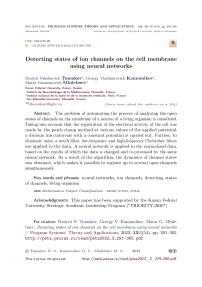Detecting states of ion channels on the cell membrane using neural networks
Автор: Tumakov Dmitrii Nikolaevich, Kannunikov Georgy Vladimirovich, Minlebaev Marat Gusmanovich
Журнал: Программные системы: теория и приложения @programmnye-sistemy
Рубрика: Искусственный интеллект, интеллектуальные системы, нейронные сети
Статья в выпуске: 3 (54) т.13, 2022 года.
Бесплатный доступ
The problem of automating the process of analyzing the open states of channels on the membrane of a neuron of a living organism is considered. Taking into account that the registration of the electrical activity of the cell was made by the patch clamp method at various values of the applied potential, a division into intervals with a constant potential is carried out. Further, to eliminate noise, a notch filter, low-frequency and high-frequency Chebyshev filters are applied to the data. A neural network is applied to the normalized data, based on the results of which the data is changed and re-processed by the same neural network. As a result of the algorithm, the dynamics of channel states was obtained, which makes it possible to register up to several open channels simultaneously.
Neural networks, ion channels, detecting states of channels, living organism
Короткий адрес: https://sciup.org/143179408
IDR: 143179408 | DOI: 10.25209/2079-3316-2022-13-3-291-305
Список литературы Detecting states of ion channels on the cell membrane using neural networks
- K. Qu, F. Guo, X. Liu, Y. Lin, Q. Zou. “Application of machine learning in microbiology”, Frontiers in Microbiology, 10 (2019), 827, 19 pp. https://doi.org/10.3389/fmicb.2019.00827
- A. Egli. “Digitalization, clinical microbiology and infectious diseases”, Clinical Microbiology and Infection, 26:10 (2020), pp. 1289–1290. https://doi.org/10.1016/j.cmi.2020.06.031
- S. J. Goodswen, J. L. N. Barratt, P. J. Kennedy, A. Kaufer, L. Calarco, J. T. Ellis. “Machine learning and applications in microbiology”, FEMS Microbiology Reviews, 45:5 (2021), fuab015, 19 pp. https://doi.org/10.1093/femsre/fuab015
- N. Peiffer-Smadja, S. Dellière, C. Rodriguez, G. Birgand, F.-X. Lescure, S. Fourati, E. Ruppé. Machine learning in the clinical microbiology laboratory: Has the time come for routine practice? Clinical Microbiology and Infection, 26:10 (2020), pp. 1300–1309. https://doi.org/10.1016/j.cmi.2020.02.006
- A. N. Nielsen, D. M. Barch, S. E. Petersen, B. L. Schlaggar, D. J. Greene. “Machine learning with neuroimaging: Evaluating its applications in psychiatry”, Biological Psychiatry: Cognitive Neuroscience and Neuroimaging, 5:8 (2020), pp. 791–798. https://doi.org/10.1016/j.bpsc.2019.11.007
- O. Barak. “Recurrent neural networks as versatile tools of neuroscience research”, Current Opinion in Neurobiology, 46 (2017), pp. 1–6. https://doi.org/10.1016/j.conb.2017.06.003
- G. R. Yang, X.-J.Wang. “Artificial neural networks for neuroscientists: A primer”, Neuron, 107:6 (2020), pp. 1048–1070. https://doi.org/10.1016/j.neuron.2020.09.005
- B. Sakmann, E. Neher. Single-Channel Recording, 2nd ed., Springer, New York, 1995, ISBN 978-0-306-44870-6, 700 pp. https://doi.org/10.1007/978-1-4419-1229-9
- Md. Ashrafuzzaman. “Artificial intelligence, machine learning and deep learning in ion channel bioinformatics”, Membranes, 11:9 (2021), 672, 35 pp. https://doi.org/10.3390/membranes11090672
- L. Venkataramanan, R. Kuc, F. J. Sigworth. “Identification of hidden Markov models for ion channel currents. II. State-dependent excess noise”, IEEE Transactions on Signal Processing, 46:7 (1998), pp. 1916–1929. https://doi.org/10.1109/78.700964
- F. Qin, A. Auerbach, F. Sachs. “Hidden Markov modeling for single channel kinetics with filtering and correlated noise”, Biophysical Journal, 79:4 (2000), pp. 1928–1944. https://doi.org/10.1016/S0006-3495(00)76442-3
- F. Pein, B. Eltzner, A. Munk. “Analysis of patchclamp recordings: Model-free multiscale methods and software”, European Biophysics Journal, 50:2 (March 2021), pp. 187–209. https://doi.org/10.1007/s00249-021-01506-8
- N. Celik, F. O’Brien, S. Brennan, R. D. Rainbow, C. Dart, Y. Zheng, F. Coenen, R. Barrett-Jolley. “Deep-Channel uses deep neural networks to detect single-molecule events from patch-clamp data”, Communications Biology, 3 (2020), 3, 10 pp. https://doi.org/10.1038/s42003-019-0729-3
- L. Moffatt. “Estimation of ion channel kinetics from fluctuations of macroscopic currents”, Biophysical Journal, 93:1 (2007), pp. 74–91. https://doi.org/10.1529/BIOPHYSJ.106.101212
- F. Pein, A. Bartsch, C. Steinem, A. Munk. “Heterogeneous idealization of ion channel recordings – Open channel noise”, IEEE Transactions on NanoBioscience, 20 (2021), pp. 57–78. https://doi.org/10.1109/TNB.2020.3031202
- M. A. Navarro, M. Amirshenava, A. Salari, M. Milescu, L. S. Milescu. “Parameter optimization for ion channel models: Integrating new data with known channel properties”, Computational Methods for Estimating the Kinetic Parameters of Biological Systems, Methods in Molecular Biology, vol. 2385, Humana, New York, 2021, ISBN 978-1-0716-1766-3, pp. 353–375. https://doi.org/10.1007/978-1-0716-1767-0_17
- Ye. I.Bon’, N.Ye.Maksimovich. “Structuralandfunctional characteristics of ion channels and methods for investigating their activity”, Biomeditsina, 17:1 (2021), pp. 35–42 (in Russian). https://doi.org/10.33647/2074-5982-17-1-35-42
- A. Mumuni, F. Mumuni. “CNN Architectures for geometric transformation-invariant feature representation in computer vision: A review”, SN Computer Science, 2 (2021), 340, 23 pp. https://doi.org/10.1007/s42979-021-00735-0
- Z. Kayumov, D. Tumakov, S. Mosin. “Hierarchical convolutional neural network for handwritten digits recognition”, Procedia Computer Science, 171 (2020), pp. 1927–1934. https://doi.org/10.1016/j.procs.2020.04.206
- W. Tang, G. Long, L. Liu, T. Zhou, J. Jiang, M. Blumenstein. “Rethinking 1D-CNN for time series classification: A stronger baseline”, Proc. on The Tenth International Conference on Learning Representations, ICLR 2022 (25–29 April 2022, Virtual-only), 2022, 17 pp. hUtRtpLs://www.arxiv-vanity.com/papers/2002.10061
- F.-C. Tsui, M. Sun, C.-C. Li, R. J. Sclabassi. “Recurrent neural networks and discrete wavelet transform for time series modeling and prediction”, Proc. on 1995 International Conference on Acoustics, Speech, and Signal Processing. V. 5 (09–12 May 1995, Detroit, MI, USA), IEEE, 1995, ISBN 0-7803-2431-5, pp. 3359–3362. https://doi.org/10.1109/ICASSP.1995.479705
- S. Hochreiter, J. Schmidhuber. “Long short-term memory”, Neural Computation, 9:8 (1997), pp. 1735–1780. https://doi.org/10.1162/neco.1997.9.8.1735
- C. Fahlke, D. Kortzak, J.-P. Machtens. “Molecular physiology of EAAT anion channels”, Pflügers Archiv – European Journal of Physiology, 468:3 (2016), pp. 491–502. https://doi.org/10.1007/s00424-015-1768-3
- M. Biel, C.Wahl-Schott, S. Michalakis, X. Zong. “Hyperpolarizationactivated cation channels: From genes to function”, Physiological Reviews, 89:3 (2009), pp. 847–885. https://doi.org/10.1152/physrev.00029.2008


